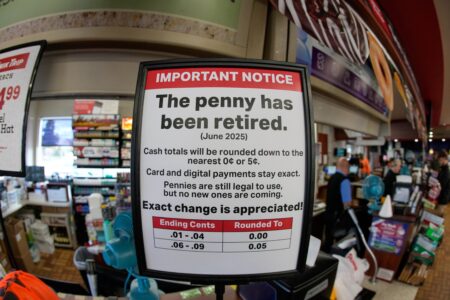Missing Information, Lack of Communication Frustrated East Palestine Derailment Response

FILE - This photo taken with a drone shows portions of a Norfolk and Southern freight train that derailed the night before in East Palestine, Ohio, on Feb. 4, 2023. The Federal Railroad Administration recently completed a review of Norfolk Southern's safety culture done in the wake of the fiery Feb. 3 derailment in Ohio, and officials plan to follow up with similar investigations of all the major freight railroads over the next year. (AP Photo/Gene J. Puskar, File)
EAST PALESTINE — February’s Norfolk Southern train derailment was described as a “low-probability but high-consequence event” Thursday during a National Transportation Safety Board hearing at East Palestine High School.
The two-day hearing, which continues today, began with a session which focused on communications and the preparedness of first responders and shined a light on the chaos following the derailment.
“I don’t think you can ever be prepared for something like this,” East Palestine Fire Chief Keith Drabick said while recounting the crippling challenges those first on the scene faced that night. Commotion replaced communication as first responders tried to assess the situation. They didn’t know if there had been any casualties. They didn’t know if the train’s crew had survived the derailment, much less where they were. And they didn’t know what was on the train.
Drabick said it took 45 minutes for emergency crews to figure out that they were fighting a chemical fire. When they did, firefighters were pulled back and an evacuation order was given.
“Our first priority is responder safety then public safety,” East Liverpool Hazmat Chief Bill Jones said. “And first responder safety was a challenge that night.”
The consist — which gives a list of all cars and contents — was requested from Norfolk Southern at 9:04 p.m. by a call from East Palestine dispatch to Atlanta. That call was not returned. Dispatch called again at 9:30 to determine if an evacuation of the town was warranted. No information was obtained from that call either.
The consist finally reached the Columbiana County Emergency Management Agency via email from Norfolk Southern at 9:56 p.m — as NTSB Chair Jennifer Homendy put it “nearly an hour after the train had derailed.”
It was 10 p.m. before Drabick received a copy of the consist and 10:23 p.m. before it reached Jones’ hands. The East Palestine police was given the consist at 1:30 a.m. and, at 2:15 a.m., Drabick found a hard copy sitting on a desk at command post.
The inability of Norfolk Southern to get the consist to the first responders concerned Homendy but she was more concerned that CTEH — a company contracted by railroad to perform air quality testing — had a copy at 9:04 p.m.
“How is it that Norfolk Southern could provide the contractors responsible for cleanup with the information within 12 minutes of the derailment and took an hour to several hours before providing it to emergency responders,” Homendy inquired. “The fire chief had to find a copy at 2:15 a.m. sitting on a desk at the command post.”
Lack of a consist from Norfolk Southern wasn’t the only breakdown in communications that night. Radios from different departments do not work in unison nor is there one designated frequency different departments use when responding to the same emergency. Emergency crews could not communicate with crews on the other side of the tracks. Another challenge was that the first crews on the scene did not have AskRail — an app that delivers the train’s manifest to first responders from rail companies that is utilized industry-wide.
Drabick said all that needs to change.
“Standards need to change across the country and they need to change in our village,” he said.
When asked if he has learned anything from the catastrophe, the fire chief didn’t hesitate.
“There were lots of lessons learned,” Drabick said. “The big thing is you can never have enough training and you can never have enough manpower.”
Beaver County Emergency Management Coordinator Eric Brewer added that crews need to be better equipped when facing derailments.
“What we had wasn’t enough for what we faced,” Brewer said. “And what East Palestine had wasn’t enough.”
The hearing also focused on department training — particularly departments that rely on volunteer crews. To become a volunteer firefighter 36 hours are required. By comparison, paid firefighters are required to undergo 200 hours of training.
The second session of the day focused on the decision to vent and burn.
Drabick took responsibility for making the final decision but said it was the consensus of unified command. He also said he was given just 13 minutes to do so.
“The final yes given by me but based on consensus by everybody else in the unified command,” Drabick said. “No objections were given when the final okay was given.”
Testimony was given by Robert Wood of Norfolk Southern and Specialized Response’s Charles “Chip” Day and Drew McCarty supporting the decision.
Conflicting data was offered by Oxy Vinyl’s Steve Smith and Paul Thomas and Dr. William Carroll of Carroll Applied Science.
Today’s hearing starts at 9 a.m. The first session will analyze the role wheel bearings and waywise detectors plated in the derailment. The second session will consider tank car safety.




